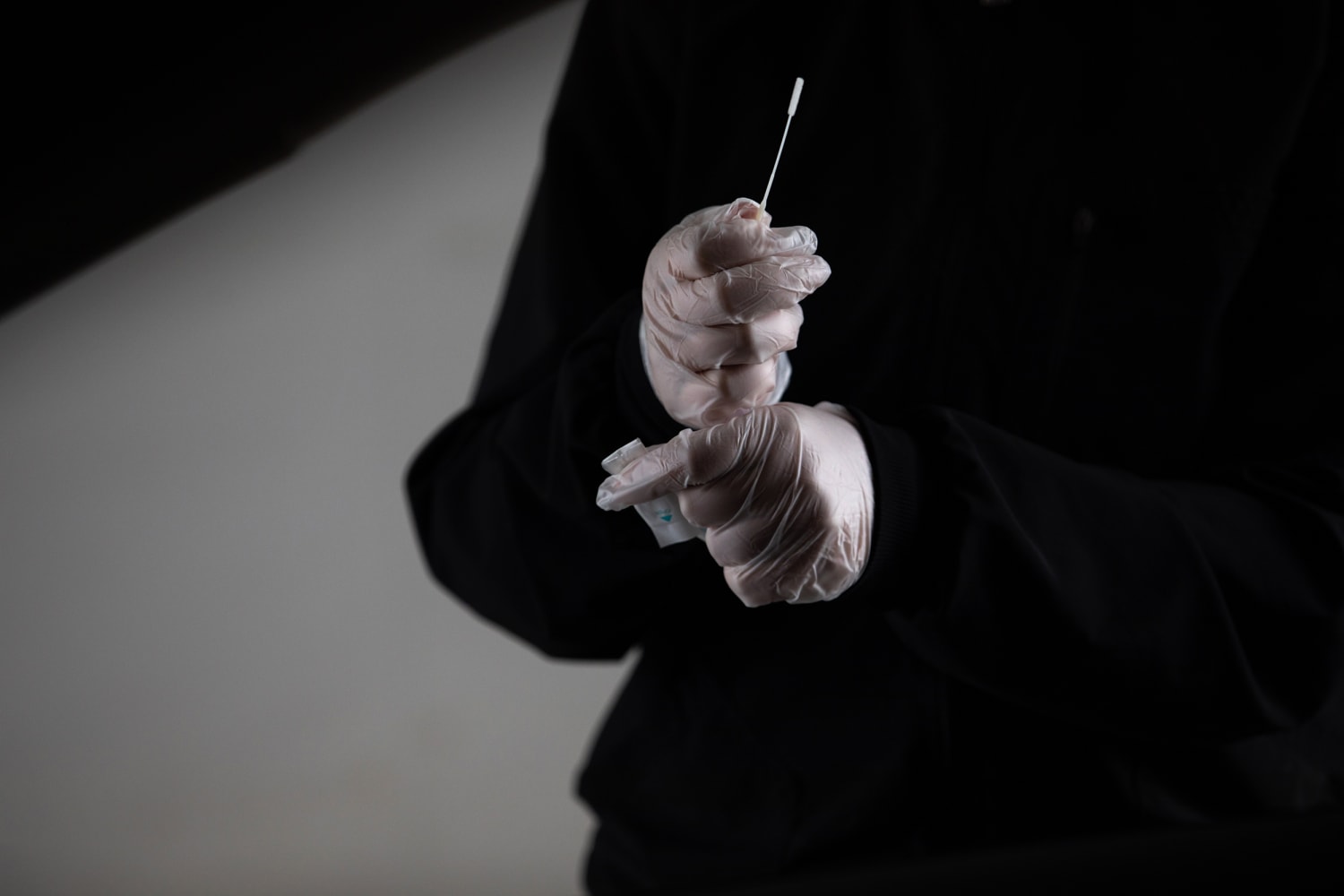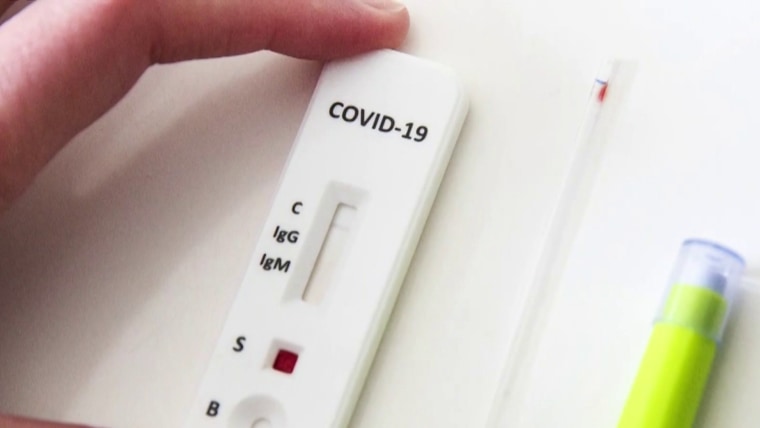As omicron cases continue to sweep the United States, the Food and Drug Administration is being urged to gather more information about how well at-home Covid-19 tests are able to detect the variant.
Evidence suggests the omicron variant of the virus may appear in the throat before it shows up in the nose. For this reason, there’s been pressure on the FDA to recommend swabbing the throat with the nasal swabs. But medical experts argue that anecdotes from people who test negative with a nasal swab at home but then test positive with a throat swab can be misleading. FDA officials say there isn’t enough data to support the practice.
“We do know the tests are picking up on omicron, but with less sensitivity,” acting FDA Commissioner Dr. Janet Woodcock said during a Senate Health Committee hearing Tuesday. “What we need to do is to see whether the throat swab could provide more sensitivity.”
The FDA is researching how at-home tests perform as a throat test. If the findings support it, an authorization could come quickly, Woodcock said. However, redesigning the at-home tests to accommodate larger swabs would take more time.
None of the at-home rapid antigen tests available over the counter in the U.S. are designed for throat swabs. There’s also a reason medical professionals are the ones who perform throat swabs for other infections, such as strep throat. Swabbing the back of your own throat is not easy to do.
“People should not use swabs that are designed as nasal swabs and try to swab their throat,” Woodcock said during the Senate hearing. “They may stab themselves.”
The United Kingdom’s National Health Service recommends swabbing both the nose and the throat when using a rapid antigen, or later flow, Covid test, the kind used at home. But the agency does not recommend only taking a sample from the throat. The Israeli Health Ministry early this week also advised people to swab both their nose and their throat when using rapid at-home tests.
“The virus grows in your nose and throat and somewhat at different time scales,” Michael Mina, chief science officer for the biotech software company eMed, who was an assistant professor of epidemiology at the Harvard T.H. Chan School of Public Health, said at a testing technology news briefing this week. “My recommendation would be all of the FDA guidance on this, but also we have to follow the science.”
Meanwhile, the FDA currently advises against taking samples from the throat when using an at-home rapid test.
“The agency recommends that individuals closely follow the tests’ instructions,” FDA spokesperson Jim McKinney told NBC News in an email. “We have always known antigen tests have lower sensitivity than molecular tests. If people believe they have Covid-19, they should get a follow-up PCR test to confirm their negative results. If a person tests positive with an antigen test, they should self-isolate and seek follow-up care with a healthcare provider to determine the next steps.”
It can be hard to actually get a good sample from the throat if you aren’t a medical professional.
Dr. Jonathan Li, Brigham and Women’s Hospital
Dr. Jonathan Li, an infectious disease physician at the Brigham and Women’s Hospital in Boston, cautions against altering the testing strategy that has been validated and authorized by the FDA. But he also noted that while he has not seen data to support taking a rapid test sample from the throat, “theoretically, it’s something that could be helpful.”
“What we’ve learned is that every variant seems to have its own characteristics, and it’s important that we not be locked into thinking we know everything based on what we’ve learned from the last variant,” he said. “We don’t want to always be fighting the last war. If there is something unusual about omicron, it’s important to pursue it and figure out if there is something we should be doing differently with this variant.”
Before advocating the altered approach, Li said, he would need to see data that showed it was effective. User error will likely be higher with self-administered throat swabs compared with nasal swabs, he said.
“There’s no intrinsic reason that if you swabbed the back of your throat and that’s where a lot of the virus is, and you had a really good sample, that a throat swab wouldn’t work with a rapid test,” he said. “But typically, people gag and it can be hard to actually get a good sample from the throat if you aren’t a medical professional.”
Another possible risk from at-home throat swabbing — residue from eating and drinking could cause a false positive, said Melissa Miller, chair of the American Society for Microbiology’s clinical and public health microbiology committee.
“The nose and the throat have different pH levels and we have seen people take Coke or coffee and put it in an antigen test and had a line to appear,” she said. “We don’t know exactly why this happens, but the hypothesis is acidity.”
“I’m not saying it won’t turn out that you can use throat swabs, we just don’t know the impact that it has yet on the test results,” she said.
When should you take an at-home Covid test?
Miller notes that a small preprint paper out of South Africa, which has not yet been peer-reviewed, suggested that more detectable virus may reside in the throat than in the nose when a person is infected with omicron compared to the delta variant, though the study compared PCR to antigen, or rapid, tests, which are not the same type of tests.
“It still tells you that the virus is likely there before in the nose, so I wouldn’t be surprised if that ends up being true. But how that translates to the at-home tests, we have to be careful about,” she said.
Miller said that although she would not be surprised if omicron indeed does show up in the throat before it does in the nose, that concrete data has yet to be shown.
“I have been critical of some of the FDA’s moves in the past but I would advise caution to not use these tests off-label before we have evidence,” she said.
According to Matt Binnicker, director of clinical virology at the Mayo Clinic, the fact that positivity rates are soaring in the U.S. is a testament to how well Covid tests are still working.
“If there was something about omicron that made it present in the throat but not in the nasal passages, we wouldn’t see positivity rates climbing like they have in the past three weeks,” he said. “Before we start getting on Twitter and saying, ‘Hey, my friend collected a throat swab, so everyone should do that,’ we should collect the data.”
According to Miller, it’s best to take a rapid test on day one, day two and day three of symptoms if you are testing negative but your symptoms persist. You should also isolate.
“If you have symptoms, you have Covid until proven otherwise,” she said.
Binnicker recommends testing three to four days after being exposed to Covid, even if you do not have symptoms.
Source: | This article originally belongs to Nbcnews.com











